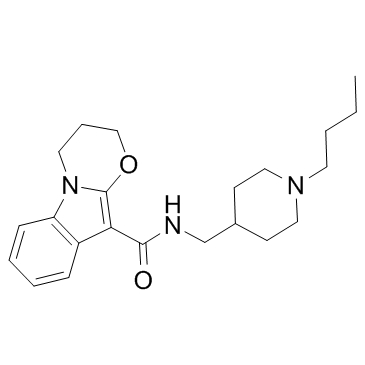| Description |
Piboserod (SB 207266) is a selective 5-HT(4) receptor antagonist.IC50 value:Target: 5-HT4 antagonistin vitro: Piboserod did not modify the basal contractions but concentration-dependently antagonized the ability of 5-HT to enhance bladder strip contractions to EFS. In presence of 1 and 100 nM of piboserod, the maximal 5-HT-induced potentiations were reduced to 45.0+/-7.9 and 38.7+/-8.7%, respectively [1].in vivo: Piboserod significantly increased LVEF by 1.7% vs. placebo (CI 0.3, 3.2, P = 0.020), primarily through reduced end-systolic volume from 165 to 158 mL (P = 0.060). There was a trend for greater increase in LVEF (2.7%, CI -1.1, 6.6, P = 0.15) in a small subset of patients not on chronic beta-blocker therapy. There was no significant effect on neurohormones, quality of life, or exercise tolerance. Patients on piboserod reported more adverse events, but numbers were too small to identify specific safety issues [2]. Pretreatment with potent 5-HT4 ligands dose-dependently reduced striatal SB207145 concentration and the effective dose to achieve 50% receptor occupancy (ED50 ) values were 4.8, 2.0, 7.4, 9.9, 3.8 and 0.02?mg/kg for GR113808, piboserod, prucalopride, RS67333, TD8954 and PF04995274, respectively [3].
|

